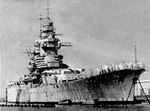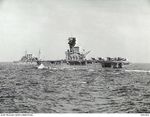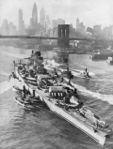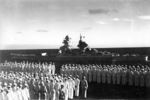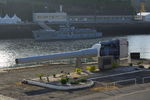Richelieu
| Revision as of 16:45, 16 March 2018 Added historical specs. | Revision as of 07:30, 17 March 2018 Added design history. | |||
| Line 192: | Line 192: | |||
| ===History=== | ===History=== | |||
| ? | + | |||
| ? | + | |||
| ? | + | |||
| ====Design==== | ====Design==== | |||
| + | The announcement by the Italian Press that two new 35,000 ton battleships would be ordered shattered the fragile balance of the naval arms race in Europe. The construction of ''[[Dunkerque]]'', although intended to counter the German Panzerschiffe, the new French capital ship outgunned and outclassed all of the older Italian capital ships. The Italians retaliated with the ''Littorio''-class, and the French needed a response. | |||
| + | Less than two weeks after the characteristics of the new Italian battleships were announced and only eight days after the order for ''Strasbourg'', ''[[Dunkerque]]''’s half-sister-ship, the defined characteristics were laid out for the new French battleships. They would displace 35,000 tons standard, have a main armament of eight or nine guns of the 380mm or 406mm caliber, be capable of a speed of 29.5-30 knots and be armored enough to resist 15” shells. It was envisaged that these new French battleships would be constructed in the same all-forward style as ''[[Dunkerque]]'', to speed up the planning and design of these new battleships and create homogenous combat groups. Early calculations quickly established that 406mm guns simply wouldn’t fit the design – 380mm was judged the maximum that could be successfully accommodated in a quadruple turret, and alternative three-turret designs using 406mm guns all came out at well over 35,000 tons. Six preliminary designs were submitted for consideration, and Project 1 was accepted, as it was, simply, an up-scale of ''[[Dunkerque]]''. | |||
| + | ||||
| + | An early concern with Project 1 was that her secondary armament of 20 130mm guns in five quadruple turrets were insufficient on a battleship of such a size; even the older ''[[Courbet]]'' and ''[[Bretagne]]'' classes had 138.6mm secondary batteries. A following request was made for studies of 152mm guns to investigate the number which could be accommodated and their proposed locations. Originally, the 152mm turrets would be complemented by six separate high-angle single 75mm guns for heavy AA purposes similar to the undertakings of the German and Italian navies, but such a plan would take Project 1, which was already 350 tons overweight, would only increase her tonnage. The 75mm guns were dropped, and instead the new 152mm turrets would have a dual-purpose function. To try and reduce weight to an acceptable 35,000 tons, new Sural boilers were accommodated into the design, which were substantially less wide than the boilers used in ''[[Dunkerque[['' and ''Strasbourg'', and the wider 33m beam of Project 1 meant that three boilers could be accommodated side-by-side, reducing the necessary boiler rooms from three to two, shortening the armored citadel by 4.85m and substantially saving weight. Weight was further reduced by cutting down armor on several areas of the ship, notably the belt; which was reduced to 330mm, but the angle of inclination was increased by 4 degrees to compensate. | |||
| + | ||||
| + | With the secondary armament and weight issues resolved, the last major project was the anti-aircraft suite. The positioning of the five 152mm turrets made it difficult to arrange the 37mm AA guns, as both the existing Mle 1925 and projected Mle 1933 guns were in open mountings. This prompted the development for a new dual-mount 37mm weapon in a fully enclosed and automated mounting. While this 37mm/70 ACAD Mle 1935 gun turned out to be a very successful weapon, the complexity of the design meant that they would not be production-ready until 1940, so the inferior 37mm/50 Mle 1933 was used as a stop-gap. These six dual 37mm mountings were complimented by a set of eight quad 132mm/76 Mle 1929 AA guns. Finally, there was enough space on the stern quarterdeck for two aviation catapults, one positioned to starboard and the other to port, and the design could easily accommodate two aircraft in the hanger, one on each catapult, and a fifth atop the hanger. | |||
| + | ||||
| + | The design was finalized, and two ships based on the Project 1 design were ordered and were subsequently named ''Richelieu'' and ''Jean Bart''. ''Richelieu'' and her sister were essentially an enlarged ''[[Dunkerque]]'' and ''Strasbourg''. Their hulls were virtually identical, with the 330mm quadruple turrets upgunned to 380mm in the same layout, and the 130mm dual-purpose quad/twin secondary turrets were replaced with 152mm DP guns all in triple turrets. The key difference was beneath the hood; ''Richelieu'' made use of the new and revolutionary Sural boilers, with six on-board separated into two boiler rooms with three boilers each. This allowed ''Richelieu'' to attain a greater speed of 32 knots than ''[[Dunkerque]]''’s 30 knots, despite the fact that Richelieu displaced 8,500 tons more, her boilers managed to attain 179,000 shaft horsepower on trials. | |||
| + | ||||
| + | ''Richelieu'' was laid down at the Brest Navy Yard under the Arsenal de Brest shipyard at Brest, France, on the 22nd of October 1935. She was launched on the 17th of January 1939, and was commissioned into the Marine Nationale on the 15th of June 1940, a mere seven days before the signing of the French Armistice in World War Two. | |||
| ====Service==== | ====Service==== | |||
Revision as of 07:30, 17 March 2018
{{WoWs_Ship |Promo=
|Anno=
One of the most successful and well-balanced "new generation" battleships in the world. The ship was equipped with 380 mm guns, had a high speed, strong armor and very good torpedo protection. The disadvantages of concentrating the ship's main guns on the bow were compensated by the favorable turret traverse angles.
|Performance= Tier VIII's ' possesses more than a passing similarity to Tier VI premium Dunkerque, but provides greater flexibility. ' is one of the fastest battleships in the game, has good relative immunity to catastrophic damage due to her armor scheme and ability to angle well, and her anti-aircraft armament allows for greater independent operation than many of her same-tier counterparts.
Captains will find Richelieu to be an excellent flanking ship even when there exists little support. Even in Tier IX or X battles the basic fundamentals of the ship do not change, but simply require greater caution. With proper map awareness, ' can remain a threat in nearly any battle. Players should actively seek opportunities to gain the flank of potential targets and use the superior speed of ' to displace if subject to too much attention.
Similar to her slightly smaller Tier VI cousin, '’s armor scheme encourages captains to keep her bow pointed at the enemy. Her citadel extends above the waterline and she has quite a bit of freeboard; ships that get a free shot at her broadside with armor-piercing rounds are all but guaranteed to do extreme damage. Fortunately, '’s anti-aircraft defenses are stronger than most of her French contemporaries: Hull (B) represents her summer 1943 refit at the Brooklyn Navy Yard, and packs on copious quantities of the 40mm Bofors and 20mm Oerlikon cannons favored by Allied navies of the era. The end result is that her long-range AA bubble remains far weaker than her American and British counterparts, but her mid- and short-range bubbles are essentially equivalent in power.
Though the play style demanded by her unique turret arrangement is different from the other ships in the French battleship branch, ' combines speed, above-average AA, and hard-hitting guns into a comfortable-to-conn package that will remind players strongly of a better Dunkerque.
|Pros=
- All-forward main armament provides excellent angling potential.
- Superb medium and close range AA suite.
- When Sierra Mike (
 ) is equipped and with Engine Boost
) is equipped and with Engine Boost  active, becomes the fastest battleship in the game.
active, becomes the fastest battleship in the game.
- Well protected citadel.
- Good maneuverability.
- Superb main battery range.
|Cons=
- Poor aft coverage for main armament.
- Poor forward coverage for secondary armament.
- Poor concealment compared to same-tier counterparts.
- Extensive coverage of Tier VIII common plate (32mm) means high vulnerability to 150mm and larger high explosive shells.
- Hull (B) loses access to both aircraft consumables.
|Research= Availability of researchable upgrades for ' is as follows:
- Hull: Upgrade to Hull (B) for a significant increases in health, anti-aircraft firepower, and rudder traverse time. Research of this module unlocks progression to Alsace. Richelieu also loses access to Spotting Aircraft
 and Catapult Fighter
and Catapult Fighter  with this upgrade.
with this upgrade.
- Gun Fire Control System: Upgrade to PCA n° 8 Mle 2 for an extra 10% range on the main battery.
- Propulsion: Upgrading this module adds an additional 1.5 knots of top speed.
Given her excellent main battery range, players will likely want to prioritize '’s Hull (B) upgrade for increased AA defenses and greater maneuverability followed by the Engine upgrade for her excellent speed. Her Fire Control System upgrade is neither particularly necessary or even needed.
|OptimalConfiguration= ' is best configured to augment her main battery and AA suite, with any remaining slots dedicated to concealment and damage control.
|Upgrades= The recommended upgrades for ' are as follows:
- Slot 1: Main Armaments Modification 1

- Slot 2: Damage Control System Modification 1

- Slot 3: AA Guns Modification 2 (
 )
)
- Slot 4: Damage Control System Modification 2

- Slot 5: Concealment System Modification 1

|CommanderSkills= The following are recommended commander skills for '.
| Recommended Commander Skills | ||||||||
|---|---|---|---|---|---|---|---|---|
| Cost (points) |
Endurance | Attack | Support | Versatility | ||||
| 1 |
★★ |
★★★ |
★ |
|
|
|
★ |
|
| 2 |
★★ |
★★ |
★ |
|
|
|
★★ |
|
| 3 |
★★★ |
|
|
|
★★ |
★★★ |
★ |
★★ |
| 4 |
★ |
★★ |
|
|
★★★ |
|
★ |
★★★ |
| Key: ★★★ - Extremely Useful ★★ - Frequently Useful ★ - Occasionally Useful No stars - Meh Χ - Not recommended | ||||||||
|Consumables= Richelieu can equip the following consumables:
- Slot 1: Damage Control Party

- Slot 2: Repair Party

- Slot 3: Spotting Aircraft
 or Catapult Fighter
or Catapult Fighter  [Hull (A) only]
[Hull (A) only]
- Slot 4: Engine Boost

Recommended premium consumables are, in order of priority: Damage Control Party II (![]() ), Repair Party II (
), Repair Party II (![]() ), Engine Boost II (
), Engine Boost II (![]() ), then Spotting Aircraft II (
), then Spotting Aircraft II (![]() ) or Catapult Fighter II (
) or Catapult Fighter II (![]() ).
).
|Camouflage= Type 1, 2, or 5 camouflage can be equipped for credits; types 1 or 5 are recommended at a minimum to reduce detectability range.
Players who wish to spend doubloons can equip ' with Type 18 camouflage which lowers her detection radius, reduces the accuracy of incoming shells, reduces her repair costs, and increases the amount of experience she earns.
|Signals= The following are recommended combat signals for '. Economic signals will be left to the discretion of the player.
Recommended Signal Flags 
| |||||
|---|---|---|---|---|---|
| Combat | |||||
 ★ |
 ★★ |
 ★★★ |
 ★ |
 ★ |
 ★ |

|
 ★ |
 ★★ |
 ★★ |
 ★★ |
 ★★★ |

|

| ||||
Note: Use of the Juliet Charlie signal makes detonation impossible.
|History=
Contents
', 1943
Construction
- Arsenal de Brest, Brest, France
- Laid down: 22 October 1935
- Launched: 17 January 1939
- Commissioned: 15 June 1940
Specifications
- 35,000 tons displacement, standard
- 247.9m length
- 33m beam
- 9.7m draft
Machinery
- Six Indret Sural boilers, four Parsons geared turbines
Performance
- 32 knots at 155,000 shaft horsepower
- 9,850 nm at 16 knots
Armor
- Main belt: 330mm
- Torpedo bulkhead: 165mm
- Decks: 170mm-150mm
- Bulkheads: 355mm-150mm
- Barbettes and Turrets: 430mm-405mm
- Conning tower: 340mm
Armament
Main
- Eight (2x4) 380mm/45 Mle 1935 guns
Secondary
- Nine (3x3) 152mm/55 Mle 1930 guns
- Twelve (6x2) 100mm/45 Mle 1933 DP guns
Anti-aircraft
- Fourty-eight (48x1) 20mm/70 Oerlikons AA guns
- Fifty-six (14x4) 40mm/56 Bofors AA guns
History
Design
The announcement by the Italian Press that two new 35,000 ton battleships would be ordered shattered the fragile balance of the naval arms race in Europe. The construction of Dunkerque, although intended to counter the German Panzerschiffe, the new French capital ship outgunned and outclassed all of the older Italian capital ships. The Italians retaliated with the Littorio-class, and the French needed a response. Less than two weeks after the characteristics of the new Italian battleships were announced and only eight days after the order for Strasbourg, Dunkerque’s half-sister-ship, the defined characteristics were laid out for the new French battleships. They would displace 35,000 tons standard, have a main armament of eight or nine guns of the 380mm or 406mm caliber, be capable of a speed of 29.5-30 knots and be armored enough to resist 15” shells. It was envisaged that these new French battleships would be constructed in the same all-forward style as Dunkerque, to speed up the planning and design of these new battleships and create homogenous combat groups. Early calculations quickly established that 406mm guns simply wouldn’t fit the design – 380mm was judged the maximum that could be successfully accommodated in a quadruple turret, and alternative three-turret designs using 406mm guns all came out at well over 35,000 tons. Six preliminary designs were submitted for consideration, and Project 1 was accepted, as it was, simply, an up-scale of Dunkerque.
An early concern with Project 1 was that her secondary armament of 20 130mm guns in five quadruple turrets were insufficient on a battleship of such a size; even the older Courbet and Bretagne classes had 138.6mm secondary batteries. A following request was made for studies of 152mm guns to investigate the number which could be accommodated and their proposed locations. Originally, the 152mm turrets would be complemented by six separate high-angle single 75mm guns for heavy AA purposes similar to the undertakings of the German and Italian navies, but such a plan would take Project 1, which was already 350 tons overweight, would only increase her tonnage. The 75mm guns were dropped, and instead the new 152mm turrets would have a dual-purpose function. To try and reduce weight to an acceptable 35,000 tons, new Sural boilers were accommodated into the design, which were substantially less wide than the boilers used in [[Dunkerque[[ and Strasbourg, and the wider 33m beam of Project 1 meant that three boilers could be accommodated side-by-side, reducing the necessary boiler rooms from three to two, shortening the armored citadel by 4.85m and substantially saving weight. Weight was further reduced by cutting down armor on several areas of the ship, notably the belt; which was reduced to 330mm, but the angle of inclination was increased by 4 degrees to compensate.
With the secondary armament and weight issues resolved, the last major project was the anti-aircraft suite. The positioning of the five 152mm turrets made it difficult to arrange the 37mm AA guns, as both the existing Mle 1925 and projected Mle 1933 guns were in open mountings. This prompted the development for a new dual-mount 37mm weapon in a fully enclosed and automated mounting. While this 37mm/70 ACAD Mle 1935 gun turned out to be a very successful weapon, the complexity of the design meant that they would not be production-ready until 1940, so the inferior 37mm/50 Mle 1933 was used as a stop-gap. These six dual 37mm mountings were complimented by a set of eight quad 132mm/76 Mle 1929 AA guns. Finally, there was enough space on the stern quarterdeck for two aviation catapults, one positioned to starboard and the other to port, and the design could easily accommodate two aircraft in the hanger, one on each catapult, and a fifth atop the hanger.
The design was finalized, and two ships based on the Project 1 design were ordered and were subsequently named Richelieu and Jean Bart. Richelieu and her sister were essentially an enlarged Dunkerque and Strasbourg. Their hulls were virtually identical, with the 330mm quadruple turrets upgunned to 380mm in the same layout, and the 130mm dual-purpose quad/twin secondary turrets were replaced with 152mm DP guns all in triple turrets. The key difference was beneath the hood; Richelieu made use of the new and revolutionary Sural boilers, with six on-board separated into two boiler rooms with three boilers each. This allowed Richelieu to attain a greater speed of 32 knots than Dunkerque’s 30 knots, despite the fact that Richelieu displaced 8,500 tons more, her boilers managed to attain 179,000 shaft horsepower on trials.
Richelieu was laid down at the Brest Navy Yard under the Arsenal de Brest shipyard at Brest, France, on the 22nd of October 1935. She was launched on the 17th of January 1939, and was commissioned into the Marine Nationale on the 15th of June 1940, a mere seven days before the signing of the French Armistice in World War Two.
Service
Historical Inaccuracies
- Hull (A) depicts Richelieu as it was supposed to be built by the original design, equipped with five triple 152mm turrets, six semi-automatic coaxial 37mm ACAD guns, and eight quadruple mounts of 13mm machine guns. However, none of the AA refits Richelieu actually received from 1940 to 1942, when the ship was under Vichy control, appear in the game.
- The 37mm/70 ACAD Mle 1936 had numerous development problems, resulting in delays which led to its cancellation in 1940. Only one was mounted on the patrol sloop Amiens. As a result, Richelieu was equipped with the 37 mm/50 Mle 1933 gun instead. In total there were eight twin mounts, of which none appear on either hull modules.
- Richelieu's August 1945 refit is also not represented. Nine 20mm Oerlikons were replaced by 11 single 40mm Bofors.
|Video=
|Ref=
}}








